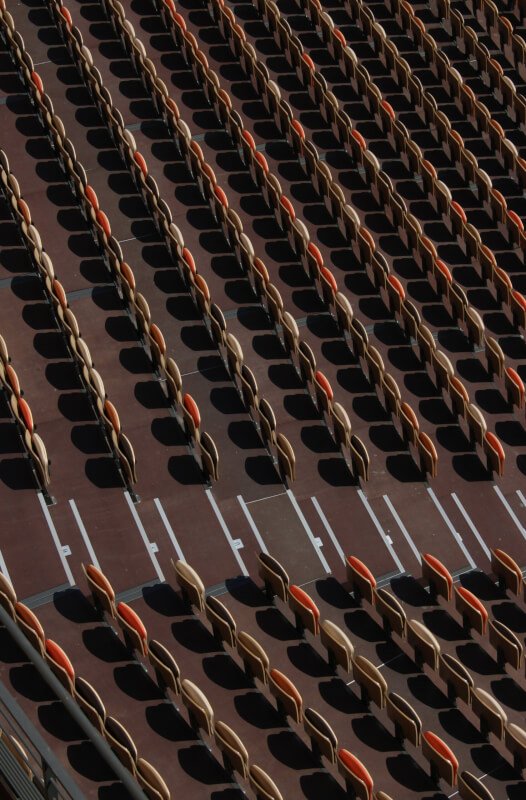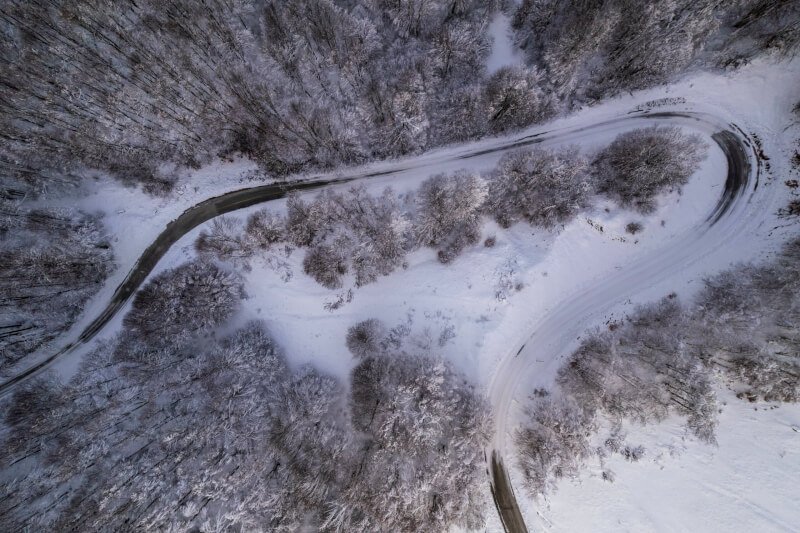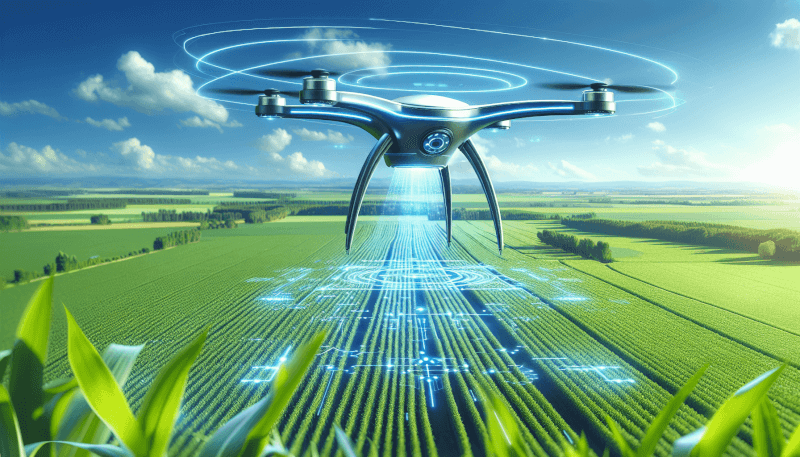In today’s technologically advanced world, the utilization of drones has expanded beyond just aerial photography and videography. With their ability to cover large areas quickly and their precise imaging capabilities, drones have become an invaluable tool for precision agriculture and crop monitoring. By equipping these unmanned aerial vehicles with specialized sensors, farmers can now gather real-time data on crop health, moisture levels, and even detect pest infestations. This article explores the various ways in which drones can revolutionize the agricultural industry and empower farmers to make informed decisions for their crops.
Benefits of using drones in precision agriculture
Enhanced crop health monitoring
Using drones in precision agriculture allows for enhanced crop health monitoring. Drones equipped with high-resolution cameras and sensors can capture detailed imagery of crops, providing farmers with valuable insights into the health and condition of their plants. By regularly monitoring crop health, farmers can identify early signs of stress, nutrient deficiencies, and diseases, enabling them to take prompt action and minimize crop damage. This proactive approach to crop health monitoring can result in higher crop yields and better overall farm productivity.
Accurate crop yield estimation
Drones offer the ability to accurately estimate crop yields, which is crucial for effective farm management. By capturing high-resolution imagery throughout the growing season, drones can generate detailed maps of crop density and plant height. Using advanced algorithms and machine learning techniques, these maps can be analyzed to provide accurate estimates of crop yields. This information enables farmers to make data-driven decisions regarding harvesting timelines, storage planning, and market strategies. Accurate crop yield estimation can lead to optimized resource allocation, increased efficiency, and improved profitability.
Time and cost-saving
One of the significant benefits of using drones in precision agriculture is the significant time and cost savings they offer. Traditional methods of monitoring crops, such as manual scouting or satellite imagery, can be time-consuming and expensive. Drones, on the other hand, can cover large areas of farmland quickly and collect high-resolution data in a fraction of the time. This efficiency allows farmers to save valuable time and resources while still gathering crucial information about their crops. By reducing the need for labor-intensive activities and costly resources, drones contribute to increased productivity and cost-effectiveness in precision agriculture.
Reduced environmental impact
Incorporating drones into precision agriculture practices can help in reducing the environmental impact of farming. Traditional methods of crop monitoring often involve the unnecessary use of fertilizers, pesticides, and irrigation, which can result in pollution and wastage of resources. Drones equipped with advanced sensors and imaging technologies can identify specific areas of crops requiring intervention, minimizing the use of chemicals and water. By applying targeted fertilization, precision pesticide application, and optimizing irrigation management, drones help farmers reduce their environmental footprint. This environmentally friendly approach to farming not only protects the ecosystem but also promotes sustainable agricultural practices.
Choosing the right drone for precision agriculture
Considerations for selecting a drone
When selecting a drone for precision agriculture, several factors need to be considered. Firstly, the drone should have a suitable flight time and range to cover the desired area effectively. Additionally, the payload capacity of the drone should support the necessary sensors and equipment needed for crop monitoring. Other considerations include the drone’s durability, ease of use, and compatibility with farm management software. It is also crucial to choose a drone from a reputable manufacturer with a proven track record in agricultural applications. By considering these factors, farmers can ensure they select a drone that meets their specific needs and requirements.
Types of drones for precision agriculture
There are various types of drones available for precision agriculture, each with its unique features and capabilities. Fixed-wing drones, resembling traditional airplanes, are known for their longer flight times and ability to cover large areas efficiently. Multi-rotor drones, on the other hand, offer vertical take-off and landing capabilities, making them suitable for capturing detailed imagery in smaller fields. Hybrid drones, combining the advantages of fixed-wing and multi-rotor designs, provide versatility and flexibility in different farming scenarios. Each type of drone has its advantages and limitations, and farmers need to evaluate their specific needs to determine which type suits their operations best.
Features to look for in a precision agriculture drone
When choosing a precision agriculture drone, certain features are essential for effective crop monitoring. Firstly, the drone should have a high-quality camera capable of capturing high-resolution imagery. This ensures the details of crops can be accurately analyzed. Additionally, the drone should have the ability to carry specialized sensors for capturing data beyond visual imagery. For example, multispectral sensors can provide valuable information about crop health and stress levels. GPS navigation and autopilot capabilities are crucial for precise flight paths and data collection. Finally, the drone’s software and compatibility with farm management systems should be considered to ensure seamless integration and analysis of data captured.

Preparing for drone flight
Get necessary permissions and licenses
Before operating a drone for precision agriculture, it is essential to obtain the necessary permissions and licenses. This includes complying with aviation regulations and obtaining any required permits or certifications from the local aviation authority. Familiarizing yourself with the specific regulations and requirements in your area is crucial to ensure compliance and avoid any legal complications. By obtaining the necessary permissions and licenses, you can operate your drone for precision agriculture in a safe and responsible manner.
Survey the area of interest
Before conducting drone flights for crop monitoring, it is advisable to survey the area of interest. This involves visually inspecting the farmland to identify potential obstacles or hazards that may affect the drone’s flight path. Any structures, power lines, or trees that could be a potential danger should be marked or avoided during the flight planning process. Surveying the area also helps in identifying potential areas of interest or specific zones that require more attention during data collection. By conducting a thorough survey of the area, you can ensure the safe and efficient operation of your drone.
Check weather conditions
Weather conditions play a significant role in the safety and success of drone flights for precision agriculture. Before taking off, it is crucial to check the weather forecast for the day and assess its suitability for flying. Strong winds, rain, fog, or other adverse weather conditions can pose risks to both the drone’s stability and the quality of the data collected. It is advisable to avoid flying in unfavorable weather conditions and reschedule the flight for a more suitable time. By monitoring and considering the weather conditions, you can ensure safer and more productive drone flights.
Capturing data with drones
Choosing the right sensors
Selecting the right sensors for your precision agriculture drone is crucial for capturing accurate and meaningful data. Different sensors offer specific capabilities for monitoring various aspects of crop health. For example, multispectral sensors capture data in multiple spectral bands, allowing for the analysis of vegetation indices such as NDVI (Normalized Difference Vegetation Index). Thermal sensors can detect variations in crop temperature, indicating possible stress or disease. The choice of sensors depends on the specific objectives of the crop monitoring and the information required. By choosing the right sensors, you can gather data that provides valuable insights into your crops.
Planning the flight path
Efficiently planning the flight path for your drone is essential for optimal data collection and coverage. The flight path should be carefully designed to ensure complete coverage of the area of interest while minimizing unnecessary overlap or gaps in data. Utilizing grid or zigzag patterns can help ensure thorough imaging of the crops. Additionally, considering the angle and altitude at which the drone will capture the imagery is crucial for obtaining detailed and accurate results. Planning the flight path in advance and utilizing software tools designed for this purpose can help ensure effective data collection and analysis.
Optimizing flight parameters
Optimizing flight parameters such as altitude, speed, and camera settings can significantly impact the quality and usefulness of the data collected. The altitude at which the drone flies affects the resolution and coverage of the imagery, with higher altitudes often providing a broader overview but sacrificing detail. The speed of the drone can affect the image sharpness, with slower speeds generally resulting in clearer images. Adjusting the camera settings, such as exposure and focus, can ensure the best quality imagery. By optimizing these flight parameters, you can capture high-quality data that enhances your ability to monitor and analyze your crops effectively.

Analyzing drone-generated data
Software for data analysis
Analyzing the data captured by drones requires specialized software designed for crop monitoring and analysis. Various software solutions are available that allow farmers to process, interpret, and visualize the data collected by their drones. These software tools utilize algorithms and machine learning techniques to generate valuable insights and actionable recommendations. They can help in identifying crop stress, nutrient deficiencies, pest infestations, and other important factors affecting crop health. Selecting a software solution that suits your specific needs and is compatible with your drone’s data format is crucial for effective analysis and decision-making.
Interpreting NDVI and other vegetation indices
Normalized Difference Vegetation Index (NDVI) is a widely used vegetation index based on the reflectance of light in different spectral bands. NDVI provides valuable information about the health and vigor of crops, enabling farmers to identify areas of stress or low productivity. By analyzing the NDVI data captured by drones, farmers can make informed decisions about fertilizer application, irrigation management, and other interventions. Other vegetation indices, such as the Green Chlorophyll Index (GCI) or the Normalized Difference Red Edge (NDRE), can provide additional insights into crop health and growth. Interpreting these vegetation indices allows farmers to assess and respond to the specific needs of their crops.
Detecting crop diseases and pests
Drone-generated data can be instrumental in detecting crop diseases and pest infestations at an early stage. High-resolution imagery captured by drones can reveal subtle changes in crop color, texture, and structure that may indicate the presence of diseases or pests. By analyzing the captured data, farmers can identify these early signs and take prompt action to prevent the spread and minimize the damage. Machine learning algorithms applied to the imagery can help detect patterns and anomalies associated with specific diseases or pests. This early detection and intervention can significantly reduce the impact of crop diseases and pests, leading to healthier and more productive crops.
Implementing drone-driven interventions
Applying targeted fertilization
One of the key interventions enabled by drones in precision agriculture is targeted fertilization. By analyzing drone-generated data, farmers can identify areas of the field with varying nutrient levels and apply fertilizers accordingly. This targeted approach minimizes excessive fertilizer use, reduces costs, and prevents nutrient imbalance in the soil. By optimizing the allocation of fertilizers based on the specific needs of different areas, farmers can promote balanced crop growth and maximize nutrient uptake efficiency. This precision in fertilization contributes to improved crop health, increased yields, and sustainable agricultural practices.
Precision pesticide application
Drones can also be utilized for precision pesticide application, minimizing the use of chemicals and reducing environmental impact. By analyzing drone-generated data, farmers can identify areas of the field where pests or diseases are concentrated. Targeted pesticide application can then be implemented, focusing only on the affected areas, rather than treating the entire field. This approach reduces chemical usage, minimizes the risk of resistance development, and preserves beneficial insects. Precision pesticide application enhances crop protection while reducing the potential harm to the environment and human health.
Irrigation management
Drones play a crucial role in optimizing irrigation management by providing precise information about crop water needs. By evaluating drone-generated data, farmers can identify areas of the field experiencing water stress or excessive moisture levels. This information helps in planning irrigation schedules, determining the optimal amount of water required, and implementing localized irrigation strategies. By applying targeted irrigation, farmers can reduce water wastage, improve water use efficiency, and prevent waterlogging or drought stress in crops. Drones enable precision in irrigation management, minimizing water consumption and promoting sustainable water resource management.

Integrating drones into existing farm management systems
Data integration and compatibility
Integrating drones into existing farm management systems requires seamless data integration and compatibility. The data captured by drones, including imagery, sensor readings, and analysis results, needs to be efficiently incorporated into existing farm management software or databases. This integration allows farmers to access all the relevant information in one platform, enabling better decision-making and streamlined workflows. It is crucial to select drones and software solutions that can produce data in formats compatible with existing farm management systems. By ensuring data integration and compatibility, farmers can maximize the value of drone-generated data and enhance their overall farm management processes.
Real-time monitoring and alerts
Drones offer the capability of real-time monitoring and alerts, providing farmers with up-to-date information about their crops. By equipping drones with live video streaming or real-time data transmission capabilities, farmers can remotely monitor their fields and receive immediate alerts about any critical situations or changes in crop health. Real-time monitoring allows for prompt decision-making and intervention, minimizing potential crop losses or damages. By leveraging the real-time capabilities of drones, farmers can achieve proactive management and effectively respond to unforeseen circumstances, thereby improving overall farm productivity and efficiency.
Collaboration with agricultural experts
Incorporating drones into farm management systems also facilitates collaboration with agricultural experts and consultants. The data captured by drones can be shared with agronomists, researchers, or other agriculture professionals for further analysis and interpretation. Collaborating with experts allows farmers to gain valuable insights and benefit from their expertise in crop management. They can receive recommendations on best practices, customized interventions, or solutions to specific challenges identified through drone-generated data. By leveraging the power of collaboration, farmers can enhance their understanding of their crops and optimize their farming strategies for better outcomes.
Overcoming challenges and limitations
Battery life and flight duration
One of the main challenges faced when using drones in precision agriculture is the limited battery life and flight duration. Most drones can only fly for a limited period of time before requiring recharging or battery replacement. This limitation can restrict the coverage area and data collection potential, especially for large farms. To overcome this challenge, farmers can invest in additional batteries or consider utilizing charging stations strategically placed throughout the farm. Optimizing flight paths and parameters to minimize unnecessary flying time can also help maximize the efficiency of drone operations despite limited battery life.
Flying in adverse weather conditions
Adverse weather conditions, such as rain, strong winds, or low visibility, pose a significant challenge for drone flights in precision agriculture. Unfavorable weather can affect the stability and control of the drone, compromising the quality of the data collected. It is important to prioritize safety and avoid flying in adverse weather conditions that could put the drone at risk or result in inaccurate and unreliable data. By closely monitoring weather forecasts and planning flights accordingly, farmers can minimize the impact of adverse weather on their drone operations.
Regulatory compliance
Another challenge when using drones in precision agriculture is ensuring compliance with aviation regulations and local laws. Different countries and regions may have specific rules and restrictions regarding drone operations, including flight altitude, airspace restrictions, or licensing requirements. It is essential to understand and adhere to these regulations to prevent legal complications and ensure the safe and responsible use of drones. Staying informed about any updates or changes in regulations and obtaining the necessary permits or licenses is crucial for successful and lawful drone operations in precision agriculture.

Ensuring data privacy and security
Securing drone communications
Securing drone communications is essential to protect the privacy and integrity of the data captured and transmitted. Encryption techniques and secure communication protocols can be utilized to safeguard the drone’s control signals and the data transmitted to/from the drone. By implementing robust security measures, farmers can minimize the risk of unauthorized access or tampering with the data, ensuring the confidentiality and reliability of their drone-generated information. It is important to prioritize data privacy and implement industry-standard security practices to maintain the trust and confidence of both farmers and customers.
Protecting against data breaches
As drones capture and transmit valuable data, including farm layouts, crop health information, and potentially sensitive business data, it is crucial to protect against data breaches. Implementing proper data storage and backup procedures, utilizing secure cloud platforms, and regularly updating software and firmware are essential practices to prevent unauthorized access and data loss. By implementing robust data protection measures, farmers can mitigate the risk of data breaches and maintain the confidentiality and integrity of their drone-generated data.
Complying with privacy regulations
In addition to securing drone data, it is important to comply with privacy regulations to respect the rights and privacy of individuals. When conducting drone flights over private properties or areas where individuals may be present, it is crucial to obtain consent and ensure compliance with applicable privacy laws. Respecting privacy regulations not only helps build trust with the community but also minimizes the risk of legal issues or reputational damage. By being aware of privacy regulations and incorporating them into drone operations, farmers can demonstrate their commitment to responsible and ethical practices.
Best practices for using drones in precision agriculture
Regular maintenance and calibration
Regular maintenance and calibration of drones are vital for their reliable and efficient operation. This includes inspecting and cleaning the drone, checking and replacing worn or damaged parts, and calibrating sensors and cameras. Regular software updates should also be performed to ensure the drone is equipped with the latest features and bug fixes. By adhering to a routine maintenance schedule, farmers can minimize the risk of technical issues or system failures during crucial operations and prolong the lifespan of their drones.
Optimal flight scheduling
Optimal flight scheduling is crucial for maximizing the effectiveness and efficiency of drone operations. This includes considering factors such as weather conditions, lighting conditions, and field access restrictions. Flying during the appropriate time of day when the lighting is optimal for capturing clear and detailed imagery is important. Additionally, avoiding high-traffic periods in the field, such as during planting or harvesting, helps ensure safety and minimize disruption. By carefully planning and scheduling drone flights, farmers can make the most of their investment and generate high-quality data for crop monitoring.
Continued training and skill development
To fully utilize the potential of drones in precision agriculture, continued training and skill development are essential. Keeping up-to-date with industry advancements, new technologies, and best practices through workshops, online courses, or professional networks is important. Familiarizing yourself with the latest drone models and software features is crucial for effective data collection and analysis. Additionally, investing in training for drone pilots and operators helps ensure competent and responsible operation. By continuously learning and improving your skills, you can make the most of your drones and enhance your precision agriculture practices.
In conclusion, the adoption of drones in precision agriculture offers numerous benefits for farmers. Enhanced crop health monitoring, accurate crop yield estimation, time and cost savings, and reduced environmental impact are among the advantages of utilizing drones in agricultural practices. Choosing the right drone involves considering factors such as flight time, payload capacity, durability, and compatibility with farm management software. Preparing for drone flight requires obtaining necessary permissions, surveying the area, and checking weather conditions. Capturing data with drones involves choosing the right sensors, planning flight paths, and optimizing flight parameters for optimal data collection. Analyzing drone-generated data requires specialized software for data analysis, interpretation of vegetation indices, and detection of crop diseases and pests. Implementing drone-driven interventions includes targeted fertilization, precision pesticide application, and irrigation management. Integrating drones into existing farm management systems involves data integration, real-time monitoring, and collaboration with agricultural experts. Overcoming challenges such as limited battery life, adverse weather conditions, and regulatory compliance is crucial for successful drone operations. Ensuring data privacy and security involves securing drone communications, protecting against data breaches, and complying with privacy regulations. Lastly, following best practices such as regular maintenance, optimal flight scheduling, and continued training and skill development helps maximize the benefits of using drones in precision agriculture. By leveraging the capabilities of drones, farmers can enhance their crop monitoring practices, optimize resource allocation, and ultimately improve their overall farm productivity and sustainability.



